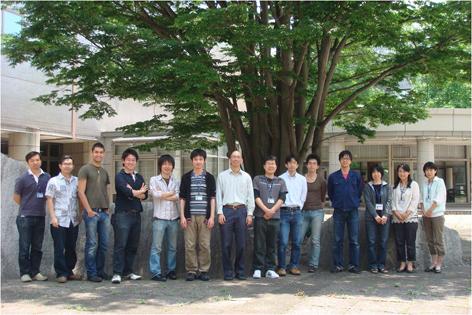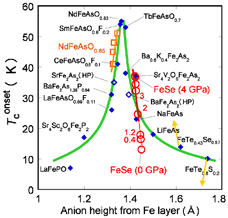National Institute for Materials Science - Japan

 JP
JP
NIMS - National Institute for Materials Science
www.nims.go.jp/eng
Organization profile:
The National Institute for Materials Science (NIMS) was established in 2001 with the merger of National Research Institute for Metals (NRIM) and National Institute in Inorganic Materials (NIRIM) as an Independent Administrative Institution. The research carried out at NIMS has two aspects, science and engineering. The goal of engineering research is to find ways to produce useful materials, while scientific research seeks to discover the physical principles underlying the properties of matter. NIMS specializes in carrying out research on materials. Our materials research is managed with the perspective of the next generation, in line with our theme “Materials research for creating tomorrow”.
Leader:
Yoshihiko Takano (M) is Group Leader at the Nano Frontier Materials Group, National Institute for Materials Science (NIMS), Tsukuba, Japan, and Professor at collaborative graduate universities, Tokyo Denki Univ., Tokyo Univ. of Science and Univ. of Tsukuba. His main research field is experimental condensed matter physics in general, and superconductivity in particular. Among his research achievements are: the discovery of a new superconducting material, namely a Li-intercalated KCa2Nb3O10, the development of a cross-whisker Josephson junction using d-wave high-Tc superconductors, and the successful synthesis of high quality MgB2 superconductors by high pressure sintering, which consequently lead to the direct observation of the two-gap nature of the superconducting order parameter in this material for the first time in the world. In 2004, he successfully synthesized boron doped diamond thin films by the chemical vapour deposition (CVD) method, and pioneered the demonstration of superconductivity in these films. He organized an international conference on this topic in 2005 and 2008. He is the author of more than 200 publications, and gave 40 invited talks at conferences in the last 5 years.
Expertise:
Crystal growth of superconducting materials including polycrystalline and single crystal samples. Crystal structural analysis using X-ray and neutron diffraction by Rietveld analysis. Transport property measurements under high magnetic field and high current and at very low temperature. Nano fabrication using FIB and EB lithography. Wire fabrication using the PIT method by rolling.
Specific facilities:
The laboratory owns several electric furnaces and high pressure synthesis machine. We also own the SQUID magnetometer up to 5 T, and 2 cryostats with superconducting magnets up to 8 T with temperature range between 0.4 K and 300 K. For crystal analysis, we have a powder X-ray diffractometer and SEM and EDX systems. For the nano fabrication, we have FIB and EB lithography and an AFM imaging machine. NIMS owns high magnetic field facilities including a hybrid magnet up to 40 T and a superconducting magnet up to 15 T for critical current measurements. We also have several high-pressure cells for transport and magnetic measurements.
Personnel assigned to this project:
Prof. Yoshihiko Takano team leader. Dr. Takahide Yamaguchi low temperature measurements and physical analysis. Dr. Shunsuke Tsuda ARPES measurements and electric structure analysis. Dr. Toshinori Ozaki sample preparation and superconductivity analysis. Dr. Yoshikazu Mizuguchi sample preparation and superconductivity analysis. Prof. Hideaki Kitazawa crystal analysis.
Main tasks in SUPER-IRON:
- Growth of single crystals of 11 phase by flux method
- Measurements in high magnetic fields up to 40T, under compressive and tensile axial strain
- Characterization of mechanical properties
- Fabrication of wire and tape prototypes of the 11 phase





 Based on the Exchange of Letters, JST and EC DG RTD have agreed to establish a new scheme for coordinated funding of Japanese-EU coordinated research projects (see European Community press release IP/09/1844). After consultations between JST and EC DG RTD, “Superconductivity” has been selected as the field of research for the coordinated funding scheme.
Based on the Exchange of Letters, JST and EC DG RTD have agreed to establish a new scheme for coordinated funding of Japanese-EU coordinated research projects (see European Community press release IP/09/1844). After consultations between JST and EC DG RTD, “Superconductivity” has been selected as the field of research for the coordinated funding scheme.